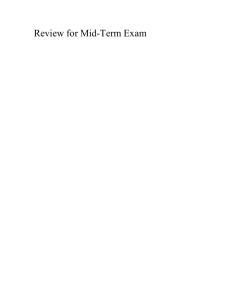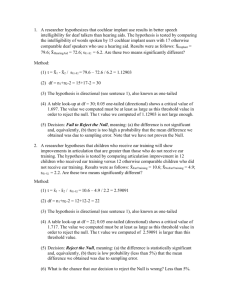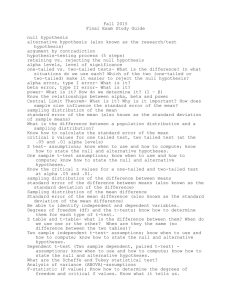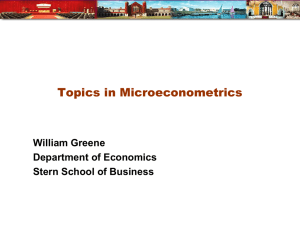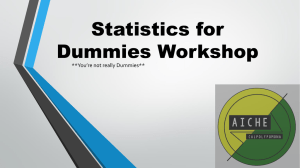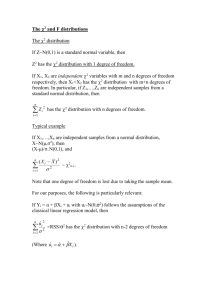CHAPTER
advertisement
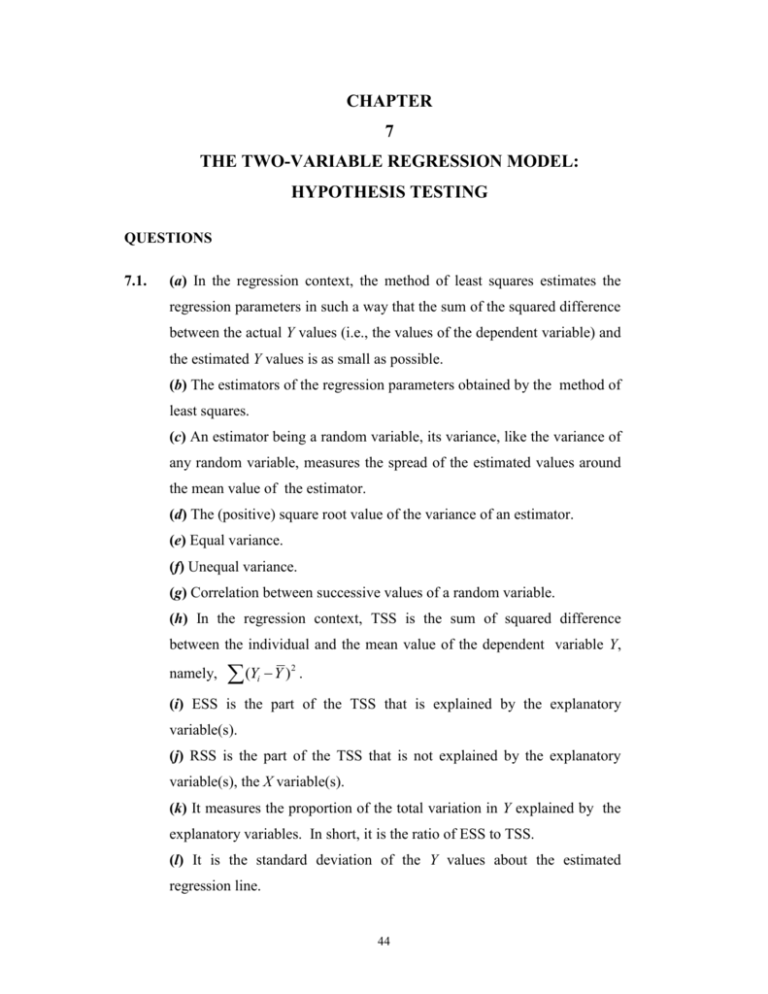
CHAPTER 7 THE TWO-VARIABLE REGRESSION MODEL: HYPOTHESIS TESTING QUESTIONS 7.1. (a) In the regression context, the method of least squares estimates the regression parameters in such a way that the sum of the squared difference between the actual Y values (i.e., the values of the dependent variable) and the estimated Y values is as small as possible. (b) The estimators of the regression parameters obtained by the method of least squares. (c) An estimator being a random variable, its variance, like the variance of any random variable, measures the spread of the estimated values around the mean value of the estimator. (d) The (positive) square root value of the variance of an estimator. (e) Equal variance. (f) Unequal variance. (g) Correlation between successive values of a random variable. (h) In the regression context, TSS is the sum of squared difference between the individual and the mean value of the dependent variable Y, namely, (Y Y ) i 2 . (i) ESS is the part of the TSS that is explained by the explanatory variable(s). (j) RSS is the part of the TSS that is not explained by the explanatory variable(s), the X variable(s). (k) It measures the proportion of the total variation in Y explained by the explanatory variables. In short, it is the ratio of ESS to TSS. (l) It is the standard deviation of the Y values about the estimated regression line. 44 (m) BLUE means best linear unbiased estimator, that is, a linear estimator that is unbiased and has the least variance in the class of all such linear unbiased estimators. (n) A statistical procedure of testing statistical hypotheses. (o) A test of significance based on the t distribution. (p) In a one-tailed test, the alternative hypothesis is one-sided. For example: H 0 : μ μ 0 against H1 : μ μ 0 or μ μ 0 , where is the mean value. (q) In a two-tailed test, the alternative hypothesis is two-sided. (r) It is a short-hand for the statement: reject the null hypothesis. 7.2. (a) False. It minimizes the sum of residuals squared, that is, it minimizes e 2 i . (b) True. (c) True. (d) False. The OLS does not require any probabilistic assumption about the error term in estimating the parameters. (e) True. The OLS estimators are linear functions of u i and will follow the normal distribution if it is assumed that u i are normally distributed. Recall that any linear function of a normally distributed variable is itself normally distributed. (f) False. It is ESS / TSS. (g) False. We should reject the null hypothesis. (h) True. The numerator of both coefficients involves the covariance between Y and X, which can be positive or negative. (i) Uncertain. The p value is the exact level of significance of a computed test statistic, which may be different from an arbitrarily chosen level of significance, . 7.7. (a) The d.f. here are 14. Therefore, the 5% critical t value is 2.145. So, the 95% confidence interval is: 3.24 2.145(1.634) = (-0.2649, 6.7449) 45 (b) The preceding interval does include B2 . Therefore, do not reject the null hypothesis. (c) t = 3.24 / 1.634 = 1.9829. Since car sales are expected to be positively related to real disposable income, the null and alternative hypotheses should be: H 0 : B2 0 and H1 : B2 0 . Therefore, an one-tailed t test is appropriate in this case. The 5% one-tailed t value for 14 d.f. is 1.761. Since the computed t value of 1.9829 exceeds the critical value, reject the null hypothesis (one- and two tail tests sometimes give different results). 7.9. (a) b1 = 21.22; b2 = 0.5344 (b) se( b1 ) = 8.5894; se( b2 ) = 0.0484 (c) r2 = 0.9385 (d) 95% CI for B1 : 1.4128 to 41.0272 95% CI for B2 : 0.4228 to 0.6460 (e) Reject H 0 , since the preceding CI does not include B2 = 0. 7.10. (a) The answers to the missing numbers are in boxes: GNPt = -787.4723 + 8.0863 M 1t se = ( 77.9675 ) r 2 = 0.9912 (0.2197) t = (-10.10001) ( 36.8061 ) (b) H 0 : B2 0 , H1 : B2 0 . The null hypothesis can be rejected. (c) No particular economic meaning can be attached to it. ˆ P = -787.4723 + 8.0863 (552) 3,676 billion. (d) GN 1984 7.12. (a) It could be negative or positive. As more output is produced as a result of increased capacity, price increases (i.e., inflation) will slow down. However, if capacity utilization is at its optimal value, and if demand pressures continue, inflation may actually rise. (b) The output in EViews format is as follows: Dependent Variable: INFLATION Sample: 1970 2001 46 Variable C CAPACITY R-squared Coefficient 11.68771 -0.090540 0.016590 Std. Error 10.22329 0.127270 t-Statistic 1.143243 -0.711399 Prob. 0.2620 0.4823 (c) The estimated slope coefficient is negative but also statistically insignificant, for the estimated p value is quite high. (d) Yes it is, for under the null hypothesis that the true slope coefficient is 1, the estimated t value is t 0.0905 (1) 8.5731 0.1272 The probability of obtaining such a t value is practically zero. (e) To get this, solve 11.6877 – 0.0905C = 0, which gives C 129.14, which may be called the “natural” rate of capacity utilization. Note: The results of the above regression are virtually insignificant. Plus, the “natural” rate of capacity utilization that was found to be 129.14 may be problematic because the measure of capacity utilization does not exceed 100. The reason for the regression breakdown is the fact that the data include the decade of the 1970s with its high rates of inflation and the mid 1970s stagflation. Running the regression over a period that excludes the 1970s, say 1982-2001, will produce more reasonable and statistically significant results. In fact, if the regression covers the 1982-2001 period, the reader can easily verify that the “natural” rate of capacity utilization is approximately 93.90. 7.14. (a) Positive. (b) and (c) The scattergram will show that the relationship between the two is generally positive, although there are a few outliers. (d) The regression results are as follows: Ŷt = 373.3014 + 0.4199 X t se = (9530.3786) t= (0.0392) (e) 99% CI: 0.0615 B2 0.7783. 47 (0.1154) (3.6406) r 2 = 0.5464 Since the preceding interval does not include zero, we can reject the null hypothesis. 7.18 (a) The EViews regression output is as follows: Dependent Variable: AVGHWAGE Sample: 1 13 Variable C YEARSSCH R-squared Coefficient -0.014453 0.724097 0.907791 Std. Error 0.874624 0.069581 t-Statistic -0.016525 10.40648 Prob. 0.9871 0.0000 (b) On the basis of the t test this hypothesis can be easily rejected, for the computed t value is highly significant; its p value is practically zero. (c) Here t 0.7240 1 3.9712 . This t value is also highly significant, 0.0695 leading to the conclusion that the education coefficient is statistically different from 1. The p value of obtaining the computed t value is 0.0011 (two-tail test). 48
